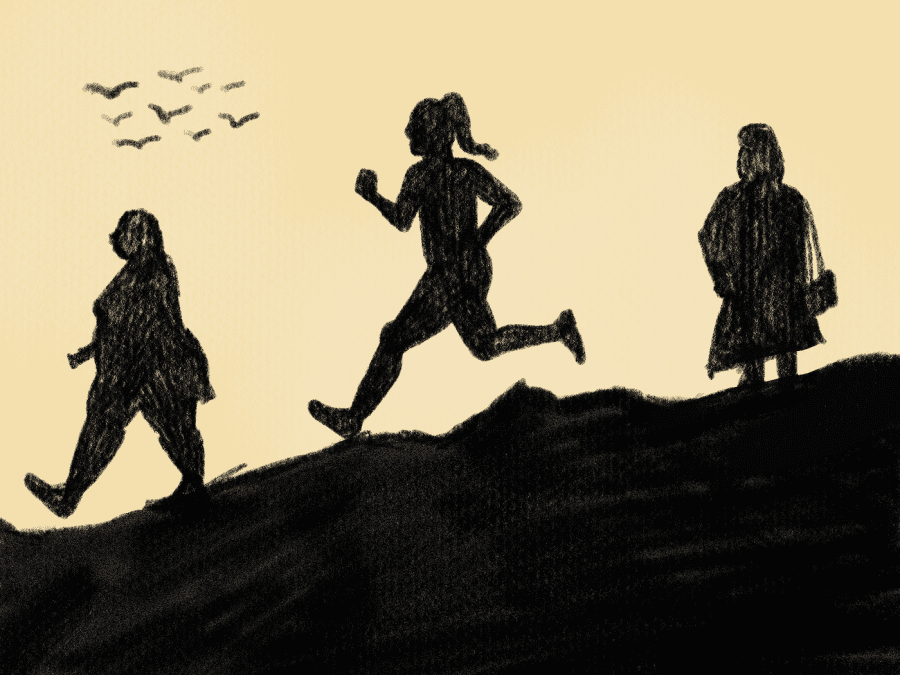Review: ‘Drive the Speed Limit’ laughs through the pain of a girl’s discomfort with her body
In an intimate play by NYU students Penelope Gould and Marina Carlstroem, “Drive the Speed Limit” takes on weight and sickness through the eyes of three generations of women.
“Drive the Speed Limit” reckons with a girl’s feeling of obligation and pain when dealing with her stomach problems. (Illustration by Susan Behrends Valenzuela)
October 12, 2022
“Drive the Speed Limit” is an independently produced show by Gallatin seniors Penelope Gould and Marina Carlstroem. They tell the story of three generations of women: Marnie (Pinky Mancuso), Laura (Hope Cassandra) and Eve (Olivia Grace). These women are not only connected through family ties, but through Eve’s struggle with severe stomach issues end up drastically affecting their lives as they attempt to alleviate her suffering.
Eve, a 17-year-old girl, is forced to come to terms with her unceasing condition and the fact that she is a fat person in a world geared toward skinny people. Gould, the playwright of “Drive the Speed Limit,” doesn’t shy away from the word “fat,” and neither does Eve. She blatantly calls herself fat, refusing to accept any of the shame associated with the word and imploring her family to stop being insulted by it as well.
Rather than weight terminology, Eve cares about the pain that emanates from her incurable stomach ailment and the compromised desire to be free from that pain in order to no longer burden her family.
“I want to be weightless,” she said in a moment of desperation.
The play opens with a conversation between Eve and her mother Laura. They’re discussing Eve’s new dietary restrictions — a never-ending list of possible solutions to her stomach pain prescribed by her doctors. As much as Laura wants to be there for Eve, there is a growing disconnect between them: the more Laura tries to help Eve with her health journey, the more embittered Eve feels.
Here, Gould hits hard at the cyclical helplessness of Eve’s family — the feeling of being trapped between obligation and love. The audience is forced to ask: What would you do if you were in Laura’s position? What about Eve’s? When your lives are occupied by pain, how long can a relationship last before dissolving into mere familial burden?
Gould paints Eve’s narrative of constant pleading for a resolution through a veil of jokes about wellness and weight. With a steady stream of ironic quips, the audience learns to laugh through the pain of watching a family struggle to find solutions. The characters are laughing, too, but maybe more so out of powerlessness over the grim absurdity of their lives.
By including extremes from each side of the diet debate of our century, Gould makes audiences understand Eve’s feelings of confusion as she looks to both her mother and grandmother’s outdated ideas about dieting, searching for just a fraction of relief. The audience laughs at her grandmother Marnie, a stereotypical ’50s Brooklynite, who goes on a comical monologue about the normality of women dieting.
Marnie recalls her own mother and her constant eating restrictions throughout her childhood. She talks about how her mother was the happiest she’d ever been with her body when battling colon cancer, because by the end of the sickness, she was 60 pounds thinner, saying “I feel so light!” The viewers laughed because perhaps Marnie’s morbid jokes hold fragments of truth about our own opinions of our bodies that are hard to admit in an age of body positivity.
“Drive the Speed Limit” is an unflinching narrative of Eve’s young life and the relationships that define it. It’s a glimpse into Eve panicking during a class presentation figuring out a way to excuse herself, sitting with her family as they curse out her doctors for another misnomered diagnosis, and a shouting match in the car between Eve and her mother as they accept that Eve’s pain isn’t going away.
The play makes the audience question what Eve would want for her life if she didn’t have to let her pain control her choices.
By the end of “Drive the Speed Limit,” Eve sits alone on the floor of her home. She looks at herself in the mirror across from where she once stood, and joked about the possibility of one day seeing her “skinny outline.” Shoots of pain run through her abdomen. There and then, the disgust of her body, her chronic pain, her mental exhaustion culminates as she starts to pull at her stomach.
She tugs harder at her skin, now pounding violently at the root of all her life’s struggles. She mimics the action of pulling out her insides, organ by organ, throwing each heavy piece to the side. She’d rather be “weightless” rather than dead.
Contact Malia Lee at [email protected].
























































































































































